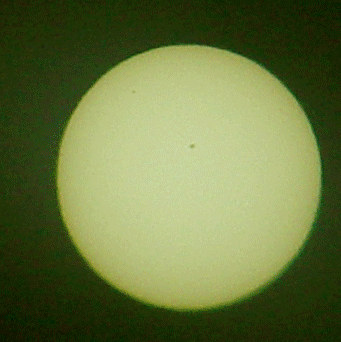Mercury Transit on May 7, 2003 Observations at ESO DO NOT FORGET THAT IT IS DANGEROUS TO OBSERVE THE SUN WITHOUT SPECIAL PROTECTION!
The only completely safe way is to project an image of the sun on a white surface (for instance, a piece of paper or cardboard). OBSERVATIONS MADE AT ESO At ESO Garching, the Mercury transit was an occasion not to be missed ! Here you will find some images of their setup as well as some results they obtained. Please note that all telescopes were fully equiped with special filters so as to allow safe observations. Some images obtained with the Meade LX200 A serie of images was made at ESO through a Webcam. These images were made with a Meade LX200 F6.3 telescope equipped with a solar filter, a Barlow lens, a camera Nikon D-100 with CCD RGB of 12-bits and a maximal resolution of 3008x2000 pixels.
Please note that the solar image is reversed by the telescope optics - this is why Mercury (the small spot on the top) is moving from right to left in these images. Some images obtained with the Celestron 8 Another serie of images was made at ESO through a real Webcam attached to a C8 telescope. Here are some images obtained. Sequence made using Binoculars and a digital camera by Chris Mullis. |  | Mercury is the tiny moving dot in the upper part of the picture. In the c enter, a small group of sunspots is visible. Because of the slow rotation of the Sun (one rotation in about 25 days), they almost did not move during the full duration of the event. Their large appa rent motion is only due to the misalignment and rotation of the image. Have a look at a composite image obtained by the GONG network and showing the motion of the sunspots during the transit. technical setup: German WWII 10x80 binoculars (Rommel's Sahara force) fitted with mylar filters Sony F717 digital camera manually butted up to the eyepiece (afocal) sequence begins about 8:30am local time, approximately 1 hour after start of transit when Sun emerged from building occultation! sequence ends at 12:30pm local time many caveats: - no correction for field rotation - color and size variations in solar disk are processing artifacts - time-sampling is non-uniform It looked MUCH better viewed directly through the binoculars, but the time-sequence is a nice record of the event. |
|
|
|
| | |